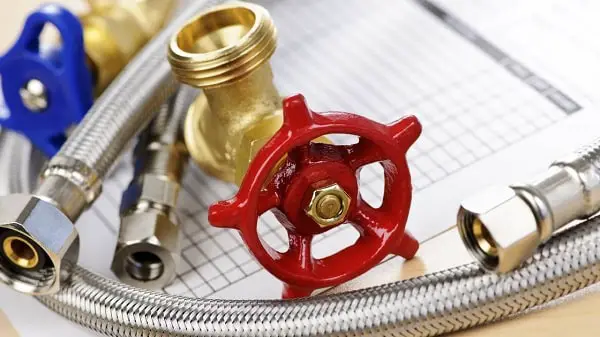A double check valve, also known as a backflow prevention device, is a critical plumbing component designed to prevent the undesired reverse flow of contaminated water back into the clean water supply.
This valve is essential in keeping away the cross-connection control issues, thereby safeguarding the quality of the water we use daily.
Do Washing Machine Need Double Check Valve in the first place?
Washing machines don’t necessarily need double-check valves, but it depends on local regulations and use. For residential use, a single check valve often suffices, while commercial use might require double-check valves. Some modern washers have built-in systems to prevent backflow, but high drainage may necessitate a valve. While not always legally required, they are advisable for protecting the water supply.
It’s important to know that, there are many types of washing machine backflow preventers available in the market and the double check valve is one of the types of backflow preventer that is commonly used.
Table of Contents
Why are double check valves used?
Double check valves serve a single yet important purpose i.e., they are employed to protect our water supply from contamination through backflow.
Backflow occurs when there’s a reversal in the flow of water, potentially leading to contaminants entering the clean water supply.
This can happen due to changes in pressure, known as back pressure, or due to siphoning, termed back siphonage.
The use of a double check valve is important in environments where there’s a risk of cross-connection between potable (drinkable) and non-potable (non-drinkable) water sources.
The double check valve acts as a backflow preventer, ensuring that water only flows in the intended direction, thereby upholding plumbing safety and water safety standards.
Are double check valves required for washing machines?
Determining whether a washing machine needs a double check valve or not is dependent on several factors, including the specific plumbing setup and prevailing local regulations.
A double check valve functions as a backflow preventer, meticulously designed to stop the reverse flow of contaminated water into the uncontaminated water supply, thereby acting as a safety shield.
Here’s a quick checklist that can help you to decide if your washer needs a double check valve or not.
Local Regulations
One of the foremost considerations is adhering to local plumbing codes and regulations.
Various jurisdictions have distinct requirements, with some mandating the installation of double check valves to fortify the water supply against potential contamination.
Hence, it’s imperative to make yourself aware and comply with these local stipulations to ascertain if your washing machine necessitates such a valve.
Commercial vs. Domestic Use
In commercial settings, where washing machines are often subjected to extensive use and higher demands, double check valves are frequently obligatory to align with health and safety standards.
On the other hand, for domestic use, the requirement for such a valve can vary depending on individual circumstances.
Risk Factors
If your washing machine is integrated with a water supply susceptible to contamination or exposure to harmful chemicals, incorporating a double check valve is advisable for enhanced safety.
The addition of a double check valve acts as a backflow prevention device, ensuring that any potential contaminants are barred from infiltrating the clean water supply.
Professional Advice
Lastly, seeking professional advice is always prudent.
Consulting with a licensed plumber or adhering to the manufacturer’s recommendations for your specific washing machine model and plumbing setup can provide tailored guidance.
Such expertise can assist in evaluating the necessity of a double check valve for washing machines, ensuring both compliance with regulations and the safeguarding of water quality.
When is it necessary to install a double check valve on a washing machine?
Determining when to install a double check valve on a washing machine relies on various factors.
It becomes essential to install one when local regulations stipulate it, particularly in areas where there is a heightened risk of water contamination.
Additionally, in commercial environments where washing machines are used extensively, the installation of a double check valve is often a necessity to meet health and safety standards.
Furthermore, if the washing machine is connected to a water supply with potential contaminants or chemicals, the installation of a double check valve acts as a backflow prevention device, enhancing safety and water quality.
Pre-requisites to Install a double check valve on a washing machine
Before installing a doubles check valve make sure that you go through the below checklist so that there are no issues post the installation.
Ideal Location
Install the double check valve in a location specified by local plumbing codes and regulations.
It is typically positioned after the water meter, offering effective backflow protection.
Valve Selection
Selecting the right valve is crucial, choose a double check valve that is compatible with the pipe’s size and flow rate to prevent leakage and ensure efficient operation.
Orientation
Double check valves can be mounted either horizontally or vertically.
It’s imperative that the valve’s orientation aligns with the flow direction in your system, adhering to manufacturer specifications and local regulations.
Maintenance Access
Accessibility for maintenance and testing is crucial as double check valves require a periodic inspection to confirm their efficacy in backflow prevention.
Surge Protection
If your system is susceptible to pressure surges, installing surge protection devices is recommended to maintain the performance of the check valves.
Compliance
Adherence to local plumbing codes and regulations is mandatory.
Non-compliance may lead to penalties and compromise the safety of your water supply.
Testing
Conduct regular testing of the double check valve to ensure its reliability in preventing backflow.
Compliance with testing protocols is typically mandated by local authorities.
Choosing between Professional installation vs. DIY
Weighing the options between professional installation and DIY is pivotal.
While professional installation ensures adherence to standards and quality, a well-informed DIY approach can also be effective, provided that all guidelines and safety measures are meticulously followed.
Installing Double Check Valve

Installing a double-check valve is a painstaking process that involves careful preparation, accurate placement, and stringent testing to ensure proper function and compliance with local regulations.
Here’s how you can install the DVC (Double-check valve) in your washing machine water connection.
Step 1: Safety and Preparation
Turn off the water supply to the designated area and unplug the appliance from the electrical outlet.
Gather all necessary tools and materials, including the double-check valve assembly, pipe wrenches, Teflon tape, and appropriate piping materials.
Step 2: Locate the Installation Point
Identify where the double-check valve will be installed.
For washing machines, the plumbing connections are typically found behind or next to the appliance.
In general plumbing scenarios, the valve should be positioned after the water meter or where backflow prevention is necessitated.
Once you have located the installation point, thoroughly clean the ends of the pipes and apply Teflon tape to the pipe fittings threads to establish a secure, leak-free connection.
Next, attach the double-check valve assembly to the appropriate pipes, following the manufacturer’s instructions closely.
Use pipe wrenches to tighten the connections securely, taking care not to over-tighten and damage the valve.
Step 3: Positioning
Ensure the valve is positioned correctly, generally at least 12 inches above the ground or floor level, although this can vary based on local regulations and the specific type of valve being installed.
Step 4: Reconnect Hoses and Turn On Water
Once everything is reconnected, turn the water supply back on and carefully inspect for any leaks around the valve and hose connections, making adjustments as necessary.
Step 5: Testing and Documentation
Conduct a test cycle to verify correct water flow, which is especially crucial for washing machine installations.
Depending on local regulations, the double-check valve may need to be tested by a certified professional to confirm proper functioning.
Maintain records of the installation, test results, and any maintenance schedules, as these may be necessary for compliance with local regulations.
Step 6: Final Steps
If applicable, plug the washing machine back in and ensure it operates as expected.
Any issues detected should be addressed immediately to prevent potential damage or contamination of the water supply.
By following these steps meticulously, the double-check valve can be installed effectively, providing a critical layer of protection against backflow contamination.
Final Thoughts
The installation of double check valves on washing machines is important for preventing the backflow of contaminated water into the clean water supply, especially critical in areas with elevated risks or where required by local regulations.
However, they also present challenges such as the need for correct installation, regular maintenance, and additional costs.
It’s highly recommended that you assess the necessity of such valves based on the machine’s usage, consult local regulations, evaluate contamination risks, seek professional advice for installation, and prioritize regular maintenance.
Despite the challenges, the protective benefits of double-check valves against water contamination make them a significant consideration.
Frequently Asked Questions
How much does a double check valve cost?
You can expect to pay between $50 and $200 for a double check valve for a washing machine. The price of a double check valve varies depending on the size, type, and brand of valve.
Where can I buy a double check valve?
You can buy double check valves at online platforms like Amazon or plumbing supply stores and home improvement centers. You can also buy them online from a variety of retailers who sell plumbing equipment.
Are double-check valves required by law?
Yes, in some areas double-check valves are required by law, especially for commercial and industrial applications. However, they may not be mandatory for residential applications hence you should check and find out if double-check valves are required in your area.
Do washing machines have non return valves?
No, most washing machines do not have non-return valves or check valves built into their design. These valves are typically not a standard feature in washing machines.
You May Also Like
- Washing Machine Water Inlet Valve: Everything To Know
- How to Replace Gas Valve in a Gas Dryer?
- How to Open OR Turn on the water valve on a Washing Machine?
- 4 Types of Faucets That Work for Portable Washing Machines
- Washing Machine Timer: What Is It and How It Works?
- How does an automatic washing machine choose water level?
- The Truth About Where Your Washing Machine Drain Water Goes





